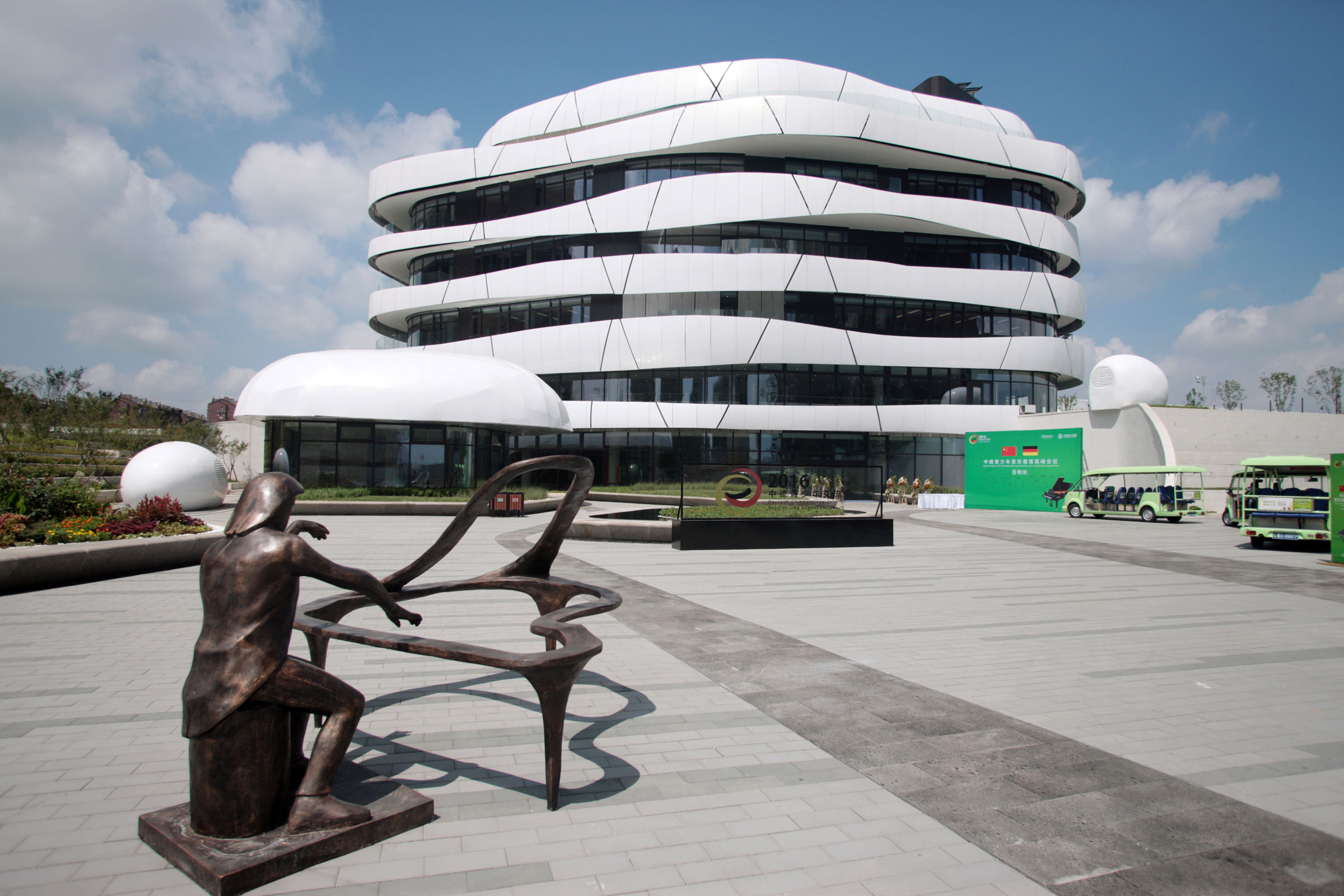Story at a glance:
- In the sixth annual Passive Projects Design Competition Phius announced finalists following a week of hootenannies.
- ICON Architecture’s Finch Cambridge took home the Best Overall Project Award.
- Phius recognized the Siemens Center in Qingdao, China as the winning commercial project.
On October 30, 2020 Phius (Passive House Institute US) announced the finalists of the 6th Annual Phius Passive House Projects Competition following a week of Passive House Hootenannies. With the help of guest judges Tessa Bradford (Smith), Arathi Gowda, Shannen Martin, Graham Irwin, and Katrin Klingenberg, the 2020 Phius design competition recognized some very impressive passive building projects around the globe.
Phius recognizes winners and honorable mentions in the categories of Single Family, Multifamily, Affordable, Commercial, School, and Source Zero as well as Best Overall Project and Best Project by a Young Professional (Under 35).
To determine the designees, the jury evaluated the entered projects on the strength of their energy performance, design, craftsmanship, use of healthy materials, level of difficulty for the given climate and site, and cost effectiveness of the affordable projects.
This year’s winners are:
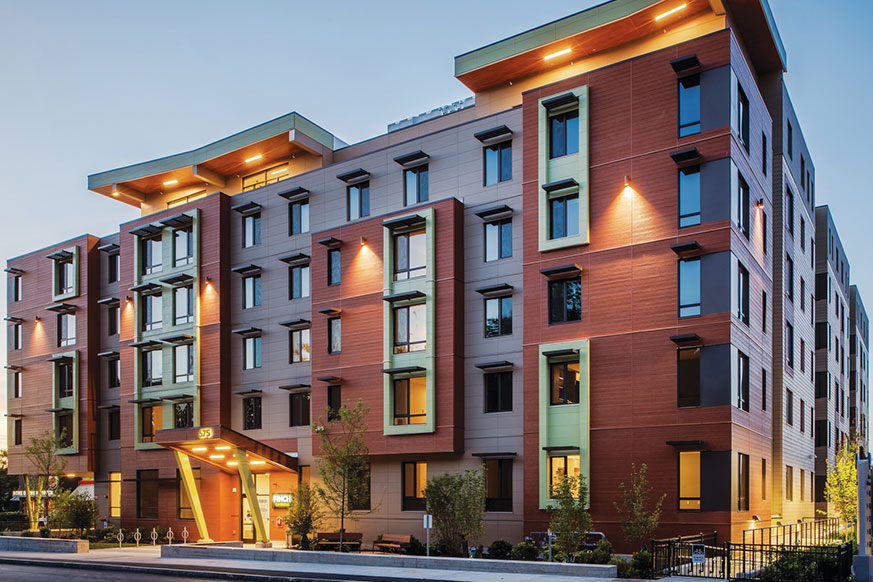
ICON Architecture’s Finch Cambridge took home the Best Overall Project Award in the 2020 Phius Design Competition. Photo courtesy of NEI Project Team
Finch Cambridge
Best Overall Project Winner, Best Project by a Young Professional Under 35 Winner, Affordable Winner
This new, 98-unit community prioritizes holistic sustainable practices to bring the first affordable passive housing building in Massachusetts. ICON Architecture designed the building to Enterprise Green criteria for affordable green housing with the goal of addressing both the climate crisis and the urgent need for affordable housing in one smart structure.
Finch Cambridge’s form and materiality recall the urban wildland of Fresh Pond reservoir. The building incorporates a large communal lobby, shared multipurpose rooms and roof decks, a welcoming open stair, thoughtful use of differentiating color by floor, and meandering paths that connect landscaped areas, including a dog park and nestled sculptural play feature.
Additionally, Finch Cambridge houses bike storage and concealed parking underneath the structure, which is elevated to protect against 2070 storm surges.
To reduce allergens and keep occupants healthy, a whole-building ventilation system provides continuous filtered fresh air to each unit while exhausting stale air. Airtight and thermal continuity, appropriate systems, and efficient lighting and appliances allow the Site Energy Use Intensity to fall to 70% less than the national average for multi-family housing.
- CPHC: Ian Johnson, Linnean Solutions
- Builder: NEI General Contracting
- Architect: ICON Architecture
- QA/QC Rater: New Ecology/JSR Adaptive Energy Solutions
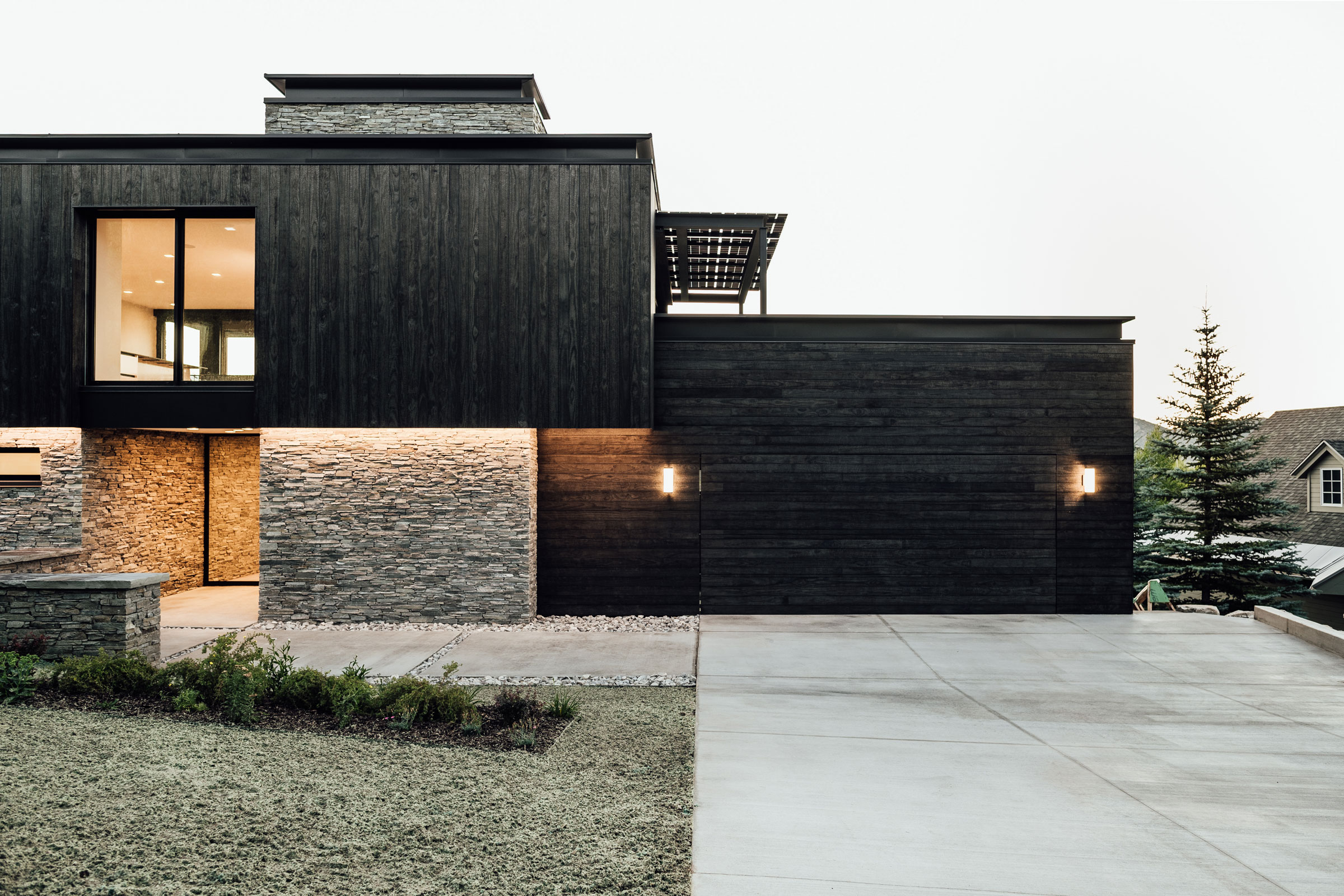
Meadows H won Best Project by at Young Professional Under 35 Honorable Mention in the 2020 Phius Design Competition. Photo courtesy of Chris Price
Meadows Haus
Best Project by at Young Professional Under 35 Honorable Mention
In Park Meadows, Park City, Utah, Klima Architecture designed this five-bedroom Passive House to peek around and above neighboring homes to maximize southern mountain views and sun exposure. Rooftop decks extend the livable space to the flat roofs with massive lift and slide glass doors.
The home features water reclamation, rainwater collection, a high-performing building envelope, solar power, low-flow fixtures, efficient appliances, low VOC and recycled materials, and more to achieve the Passive House certification.
- CPHC: Chris Price, KLIMA Architecture
- Builder: T&T Mountain Builders
- Architect: Chris Price, KLIMA Architecture
- QA/QC Rater: Dave Brach
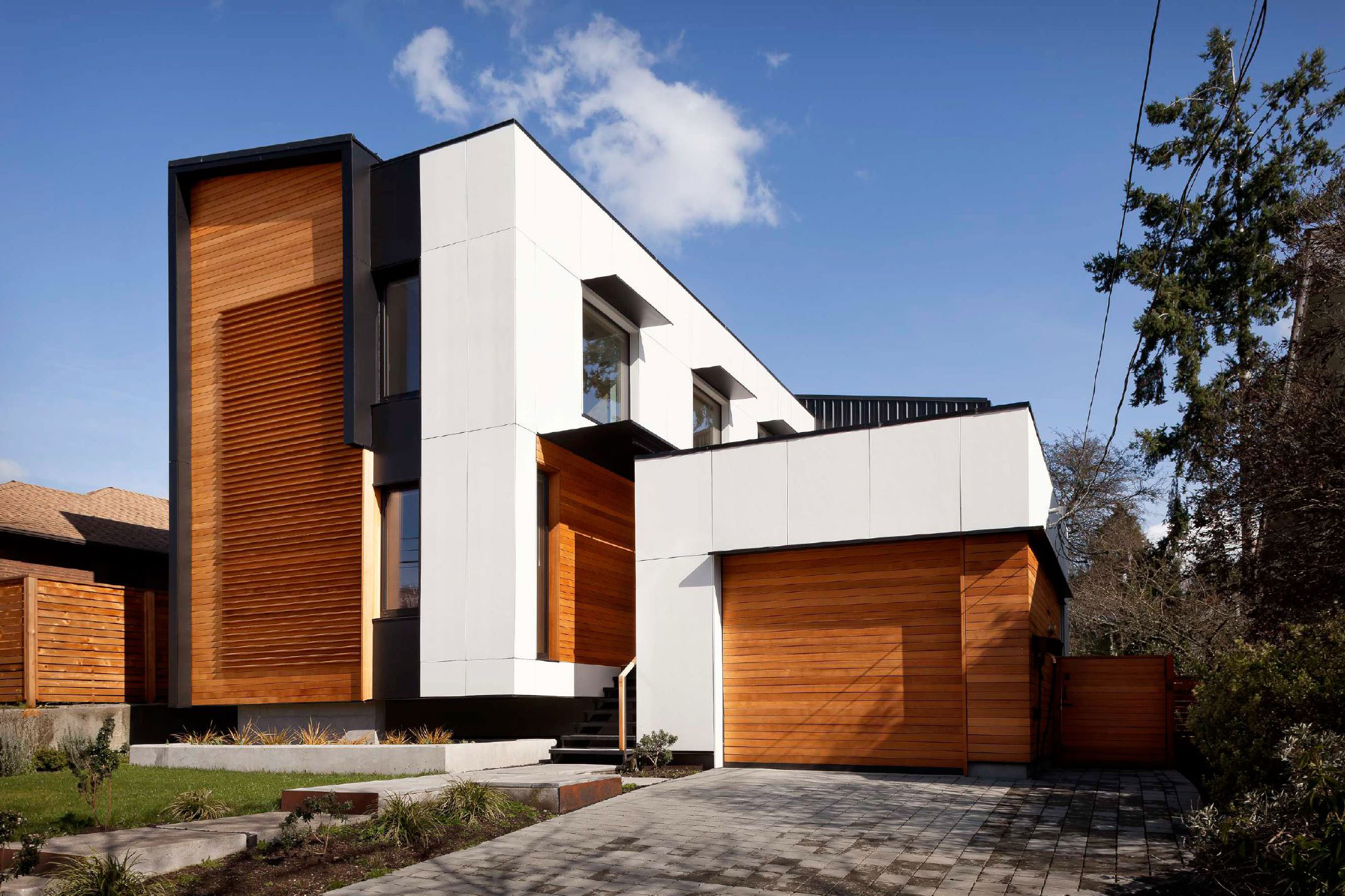
Ballard Passive House was the Single Family Winner in the 2020 Phius Design Competition. Photo courtesy of Taylor Callaway
Ballard Passive House
Single Family Winner
The Ballard Passive house, designed and constructed by First Lamp in Seattle, was completed to the requirements of the Passive House Institute in Summer 2019. The house aims to provide a calming environment full of sunlight and fresh air that enters through strategically placed windows and skylights.
The home is built on the northernmost edge of the site and wraps south to invite as much light as possible. A mega skylight over the stairs collects solar gain in the winter while steel canopies block summer sun. An interior courtyard accessible via large sliding doors links indoor and outdoor spaces and provides security and privacy in addition to a continuous flow of light and air to the living, dining, and kitchen spaces.
Exterior wood fiberboard eliminates any thermal bridging, while a heat recovery ventilator circulates healthy indoor air from the middle of the house.
- CPHC: Taylor Callaway, AIA
- Builder: First Lamp Architects – Kevin Witt, Certified Builder
- Architect: First Lamp Architects – Taylor Callaway AIA, CPHC
- QA/QC Rater: Tom Balderston, Balderson Associates
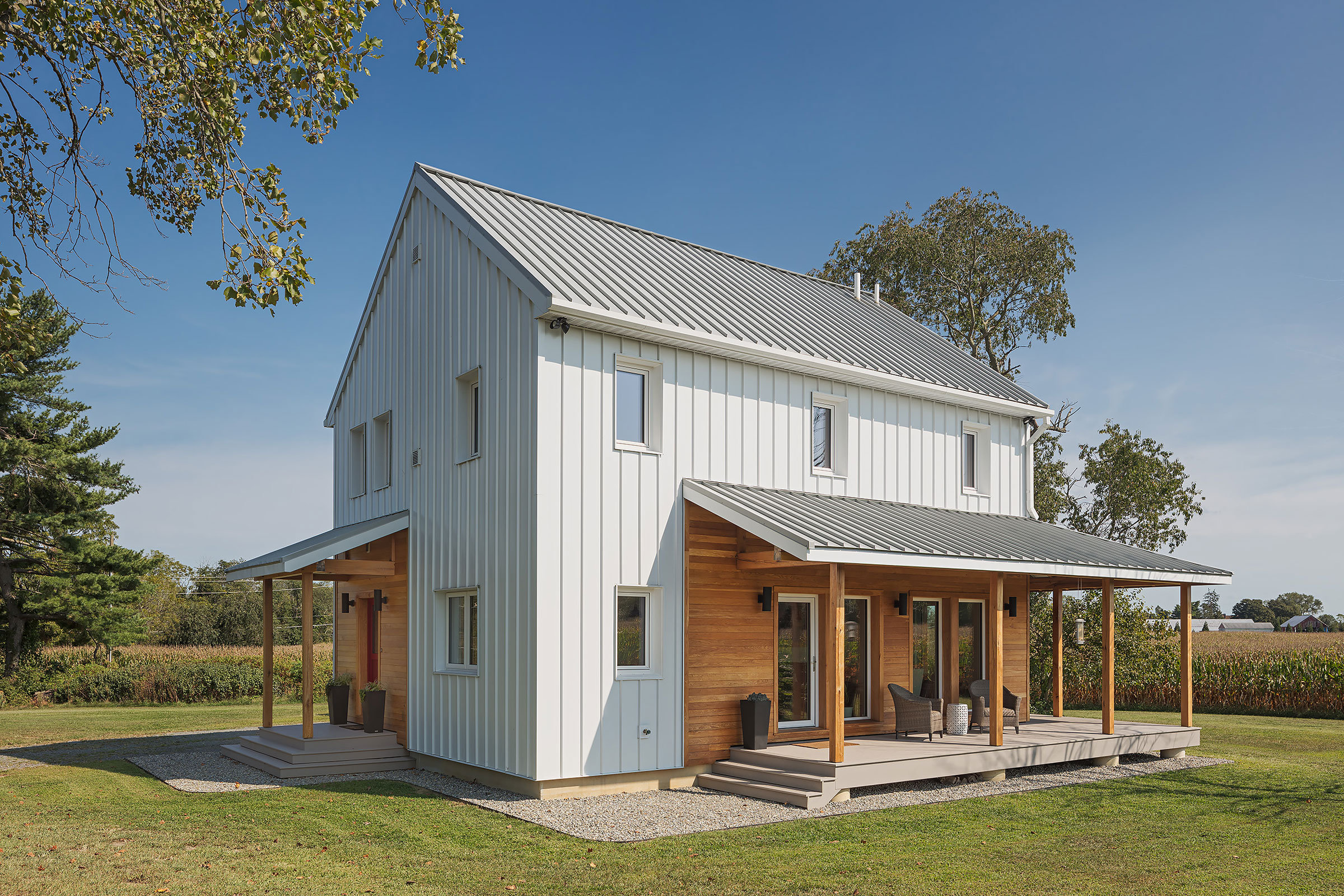
This South Jersey Passive House won the Single Family Honorable Mention in the 2020 Phius Design Competition. Photo courtesy of Sam Oberter
South Jersey Passive House
Single Family Honorable Mention
On this two-acre property surrounded by farmland in South Jersey, C2 Architecture built a home for the Roberts family to build their future. Taking a cue from the surrounding farmland, the home puts a modern twist on the farmhouse style.
A wraparound porch surrounds the home on three sides and shades the facade. Inside, high-tech systems and a super-insulated, airtight, and thermal bridge–free envelope help the home reach passive house standards while maintaining the more traditional facade. The home reaches Passive House certification without solar power, but the homeowners hope to add a photovoltaic array in the future.
- CPHC: Ilka Cassidy
- Builder: Hugh Lofting Timber Framing and High Performance Building
- Architect: C2 Architecture
- QA/QC Rater: David Berg
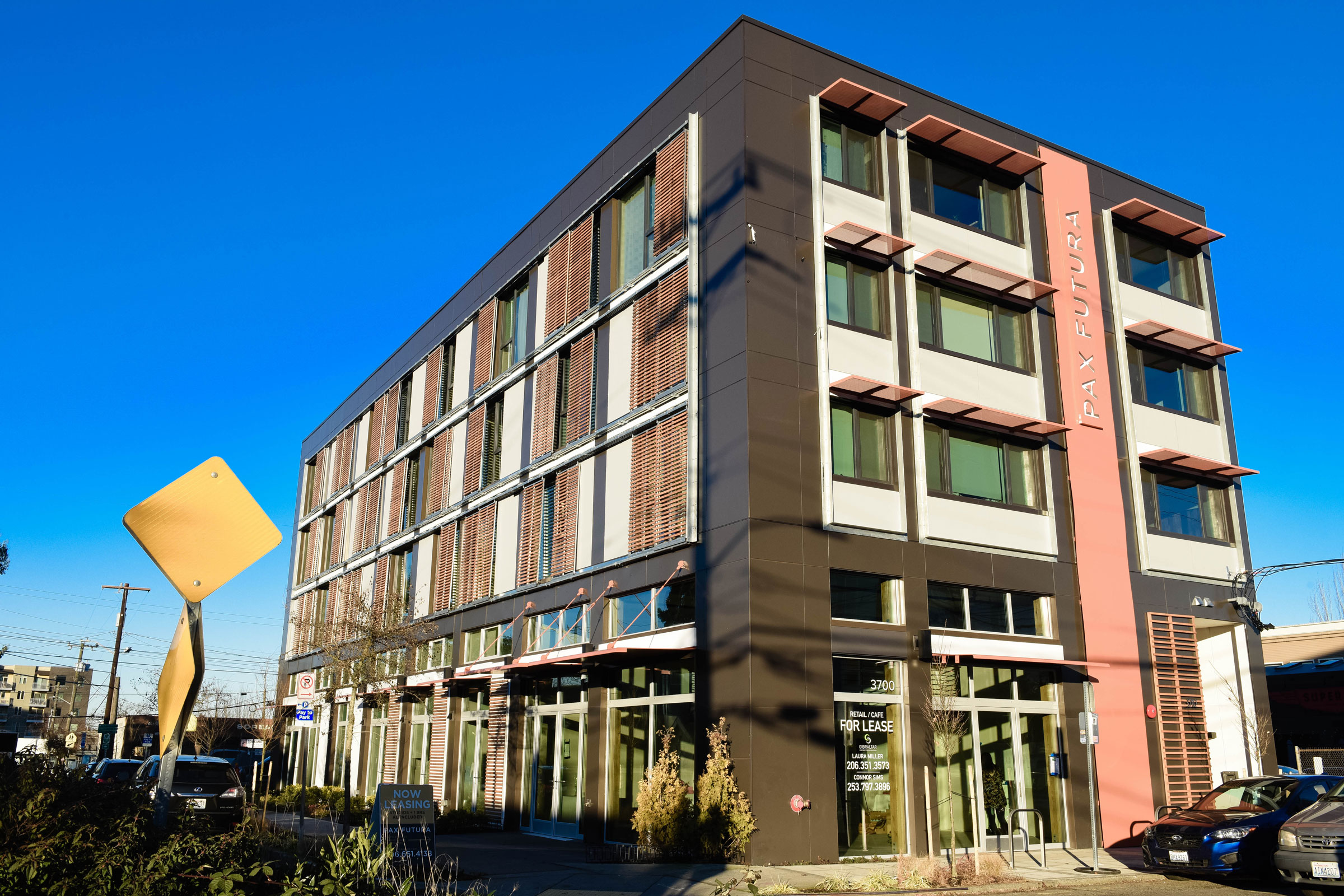
Pax Futura was the Multifamily Winner in the 2020 Phius Design Competition. Photo courtesy of Cascade Built
Pax Futura
Multifamily Winner
Located in Seattle’s Columbia City neighborhood, Pax Futura is a four-story multi-family apartment building designed by NK Architects.
As one of the first projects of this size to target Passive House certification, it achieves the standards by reducing energy to heat and cool the units by 80% compared to standard buildings.
With durable materials and construction techniques, Pax Futura emphasizes resource conservation and employs pared down mechanical systems, superior insulation, no VOC finishes, and natural bio-retention planters to manage stormwater onsite. A solar hot water system services the entire building.
Pax Futura’s shared courtyard activates the east facade with air circulation, bench overlooks, and vertical landscape and the sliding screen elements, which shields units from west-facing solar exposure, keeping units cool during warm months.
Inside, residents enjoy continuous, filtered fresh air and increased quiet and security from the high performance windows and doors.
- CPHC: Joe Giampietro + Greta Tjeltveit, Evergreen Consulting
- Builder: Sloan Ritchie, Cascade Built
- Architect: Brandon Nicholson, NK Architects, Brittany Porter, NK Architects
- QA/QC Rater: Joe Giampietro + Greta Tjeltveit, Evergreen Consulting
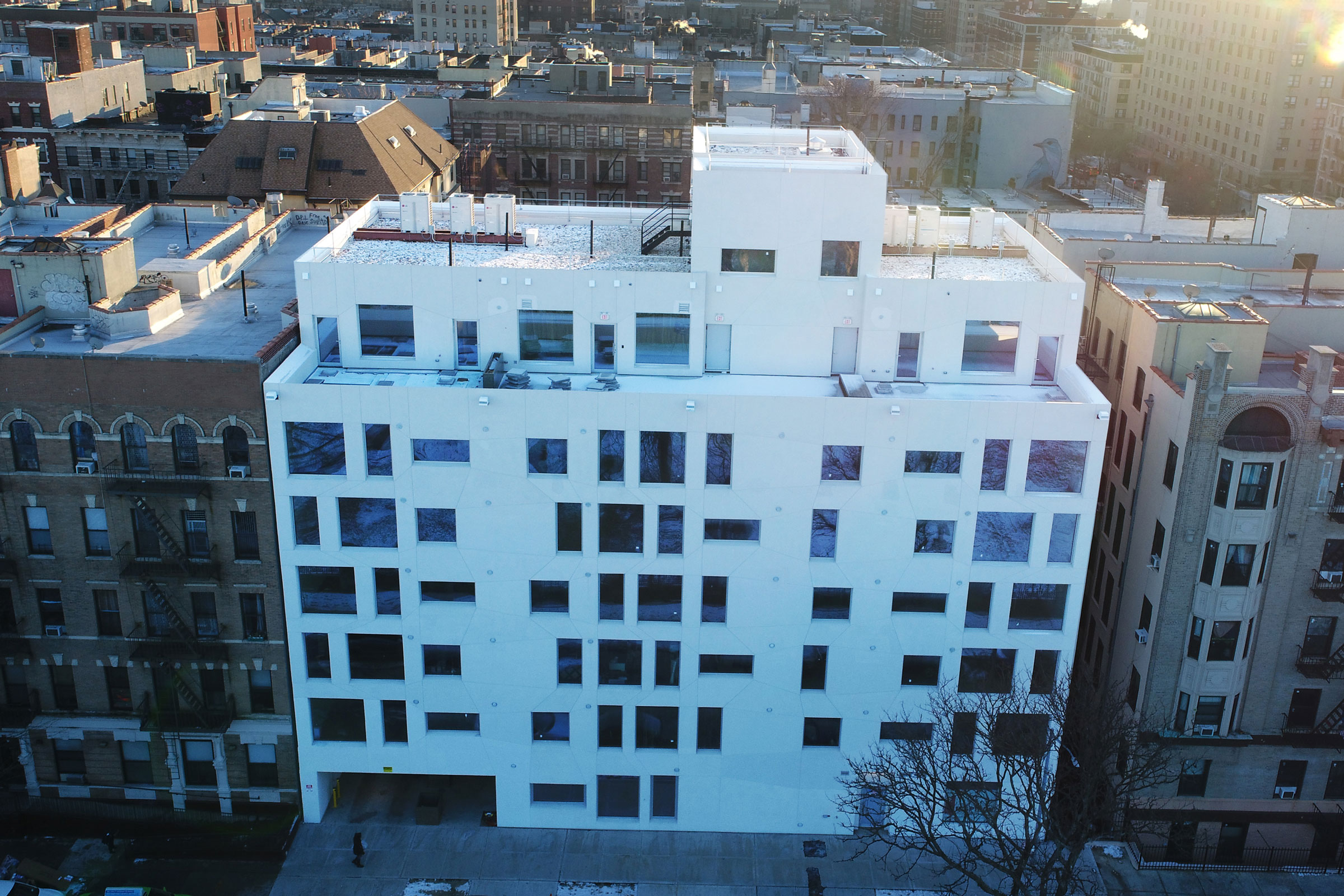
542 W 153rd Street received Multifamily Honorable Mention in the 2020 Phius Design Competition. Photo courtesy of Chris Benedict
542 W 153rd Street
Multifamily Honorable Mention
New York’s first Passive House apartment building, designed by Chris Benedict RA, earned honorable mention for its smart solutions for passive design. The 34 unit, market rate apartment building offers a variety of residential offerings in upper Manhattan, as well as views that inspire awe.
Each apartment has its own energy recovery ventilator (ERV) system and thermostat, and a variable refrigerant flow system moves waste heat from air conditioning to provide heating and cooling. Heavy insulation, superior triple-glazed windows, continuous ventilation, and compartmentation provides a wonderful space for New Yorkers to go home.
- CPHC: Henry Gifford
- Builder: Inspiron Construction
- Architect: Chris Benedict, R.A.
- QA/QC Rater: Terry Brennan
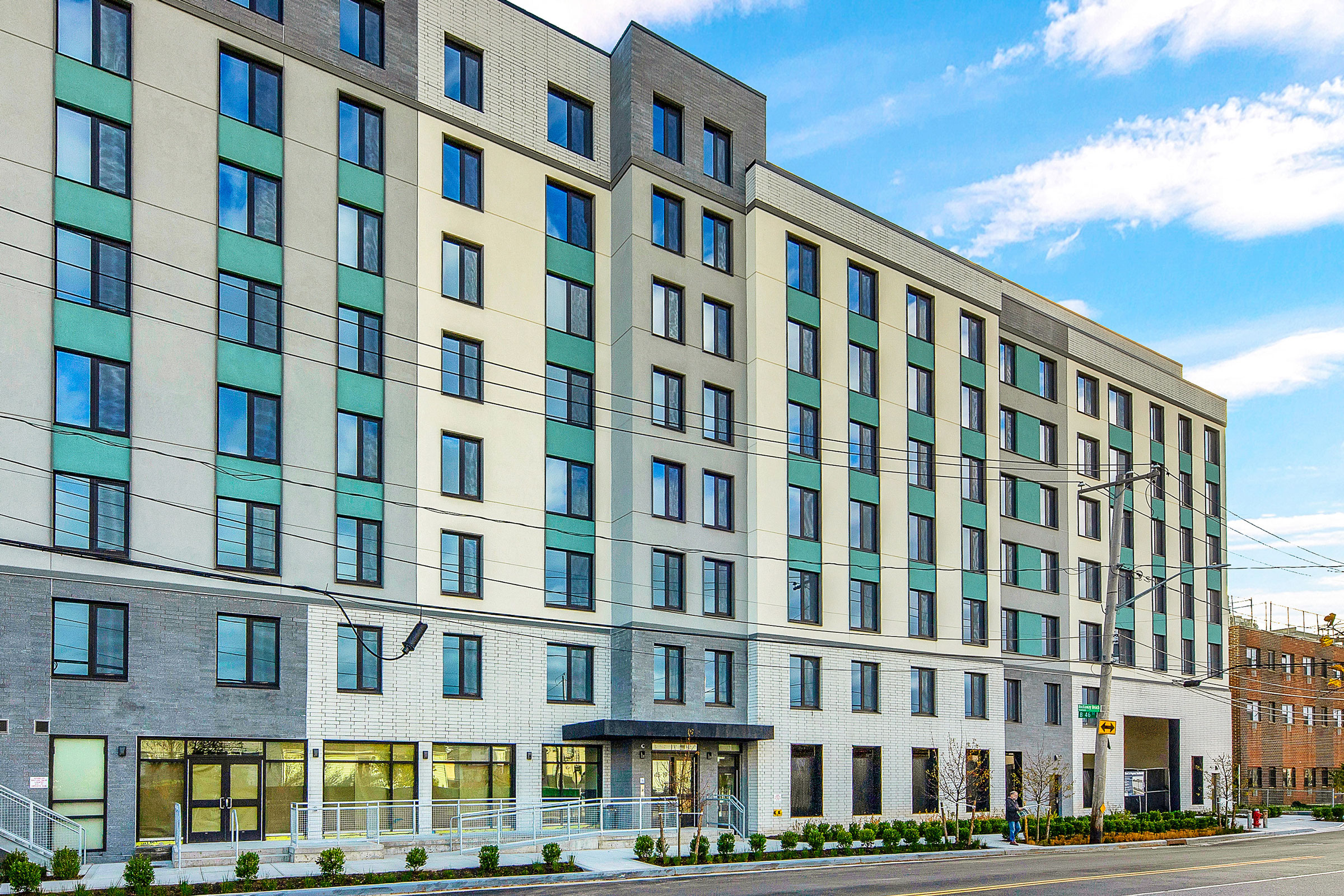
Beach Green Dunes II received the Affordable Honorable Mention in the 2020 Phius Design Competition. Photo courtesy of Sylvester Zawadzki
Beach Green Dunes II
Affordable Honorable Mention
The second development at this site in Far Rockaway, Beach Green Dunes II (BGDII) by Curtis + Ginsburg Architects demonstrates that there are many strategies that lead to Passive House certification and ultra-low energy consumption. With 127 affordable units and ample commercial space, BGDII expands spatially as well as technologically upon its sister project BGDI.
BGDII uses a brick and exterior insulation and finish systems envelope, a centralized ERV system, and a ground source heat pump for heating and cooling. Roof-mounted PV arrays generate a significant amount of electricity for the building, while southern exposure within the units takes advantage of natural light and air as well as views.
The building is constructed in a FEMA-designated Flood Zone, requiring a top notch resiliency strategy to mitigate storm damage and protect residents, who will weather in place.
- CPHC: Thomas Moore, Steven Winter Associates, Inc.
- Builder: L+M Builders Group
- Architect: Curtis + Ginsberg Architects
- QA/QC Rater: Mike O’Donnell, Steven Winter Associates, Inc.
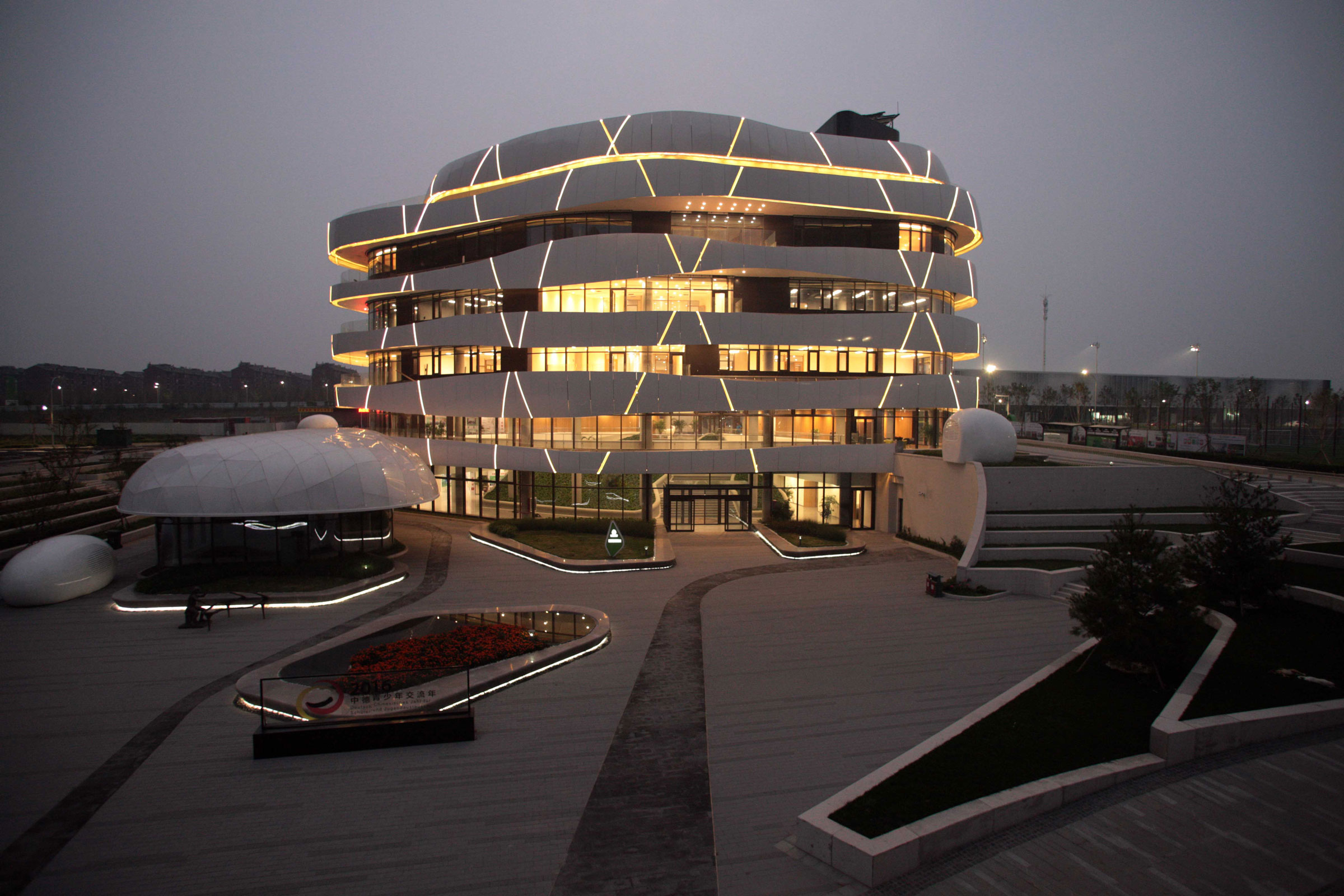
Phius recognized the Siemens Center in Qingdao, China as the winning commercial project in the 2020 Passive House competition. Photo courtesy of RoA Rongen TRIBUS VALLENTIN GmbH
Passive House Technical and Experience Center (Siemens Center)
Commercial Winner
Standing as a testament to the German-Chinese cooperation in matters of climate and environmental protection, the Siemens Center is a focal point of the Sino German-EcoPark in Qingdao, China.
Siemens Center takes the shape of a large, organic, boulder that emphasizes the design’s interaction with Passive House energy design that merge external and interior structures coherently. The joints of the balcony parapets are backlit with LED lighting that symbolize the veins of white boulders.
In addition to efficient lighting technologies, from the bulbs used to motion detecting and daylight sensors, the building uses a geothermal probe system for natural cooling and heating. In the summer, Siemens Center is cooled passively through daylighting and night cooling. A controlled ventilation system provides continuous, fresh, and well-tempered air.
- CPHC: Yes, PHI in Darmstadt, Germany
- Builder: Laixi Construction General Contracting Company
- Architect: RoA Rongen TRIBUS VALLENTIN
- QA/QC Rater: None
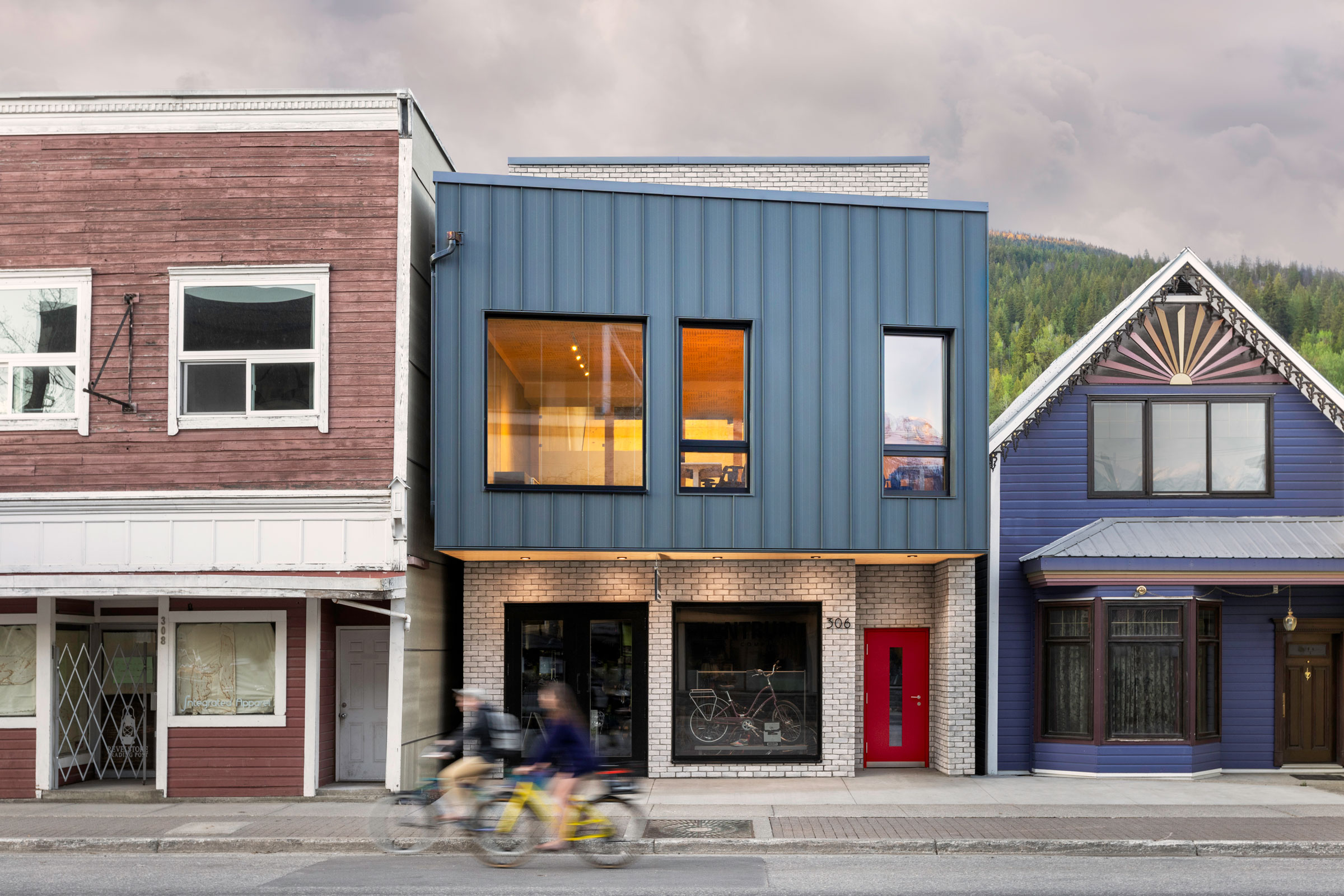
Tantrum Commercial received Commercial Honorable Mention in the 2020 Phius Design Competition. Photo courtesy of Kokemor Studio
Tantrum Commercial
Commercial Honorable Mention
This commercial Passive House project by STARK Architecture proves the benefits of exceeding design and code minimums in an urban infill lot. Among the heritage-era downtown of Revelstoke, British Columbia the three-story building houses ground-level retail space and co-lab offices above.
Prefabricated and modular systems constructed the building quickly, and CLT shear walls and wood fiber insulation helped increase build speed and reach Passive House standards. The building is oriented for daylighting and natural cooling. Double ERVs provide fresh air to the space.
- CPHC: STARK Architecture Ltd.
- Builder: Tree
- Architect: STARK Architecture Ltd.
- QA/QC Rater: Tad Everhart (Certiphiers)
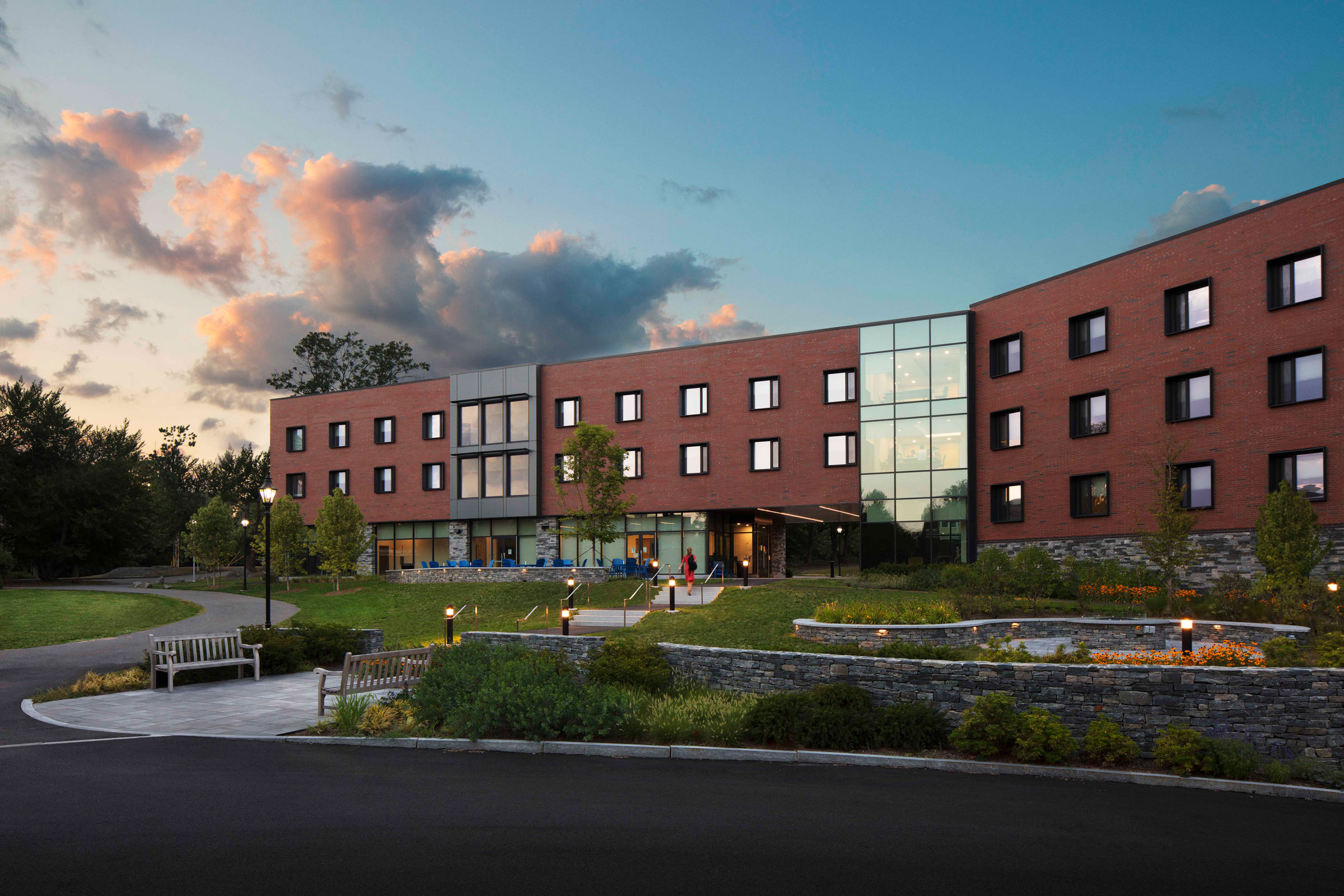
Wheaton College Pine Hall was the school winner in the 2020 Phius Design Competition. Photo courtesy of SGA
Wheaton College Pine Hall
School Winner
With 178 undergraduates housed inside, Pine Hall at Wheaton College is designed by SGA with a projected EUI of 26 and a 50% energy use reduction compared to a similar, code-designed building. The building demonstrates how Passive House strategies are possible in a large scale residence hall.
Appropriate R-values of continuous, thermal bridge free insulation, airtight construction, high performance triple glazed windows, and curtainwall exterior shading, high efficiency heating and cooling, ERV, and efficient lighting systems are all at play in the dormitory to meet Passive House standards and keep students healthy.
- CPHC: Thornton Tomasetti, SGA
- Builder: Commodore Builders
- Architect: SGA
- QA/QC Rater: Mike Browne
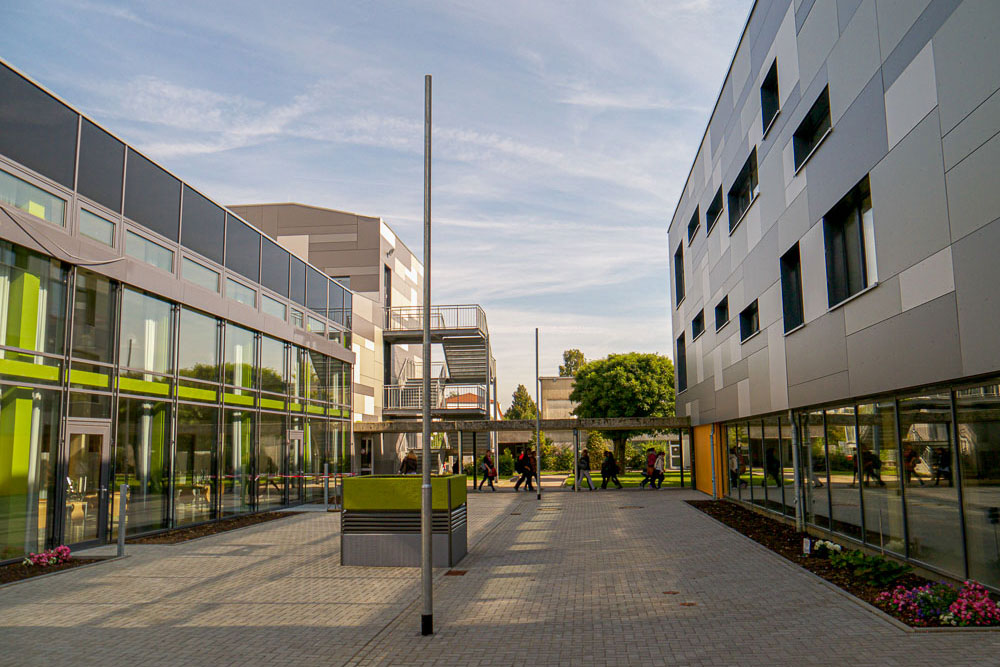
Secondary School Baesweiler received the School Honorable Mention in the 2020 Phius Design Competition. Photo courtesy of RoA Rongen Architekten
Secondary School Baesweiler
School Honorable Mention
Rongen Architekten remodeled, modernized, and expanded this German secondary school to include a cafeteria, self-study centers, ultra-modern classrooms, and an elevator for accessibility. Plus, it optimized its energy use. At the time it was the first building to use the standard for new buildings in an energy optimization of an existing building.
Compared to energy use with pre-renovation heat demand, the remodel is saving about 90.7% energy. A geothermal probe system, passive cooling in the summer, automatic window opening for night cooling, controlled ventilation, and natural light and motion sensor-controlled light all help reach the energy saving goals. A thermal solar system also provides hot water to the gymnasium.
- CPHC: Yes, PHI in Darmstadt, Germany
- Builder: Many different companies are involved
- Architect: Rongen Architekten
- QA/QC Rater: Sibylle Roßmann
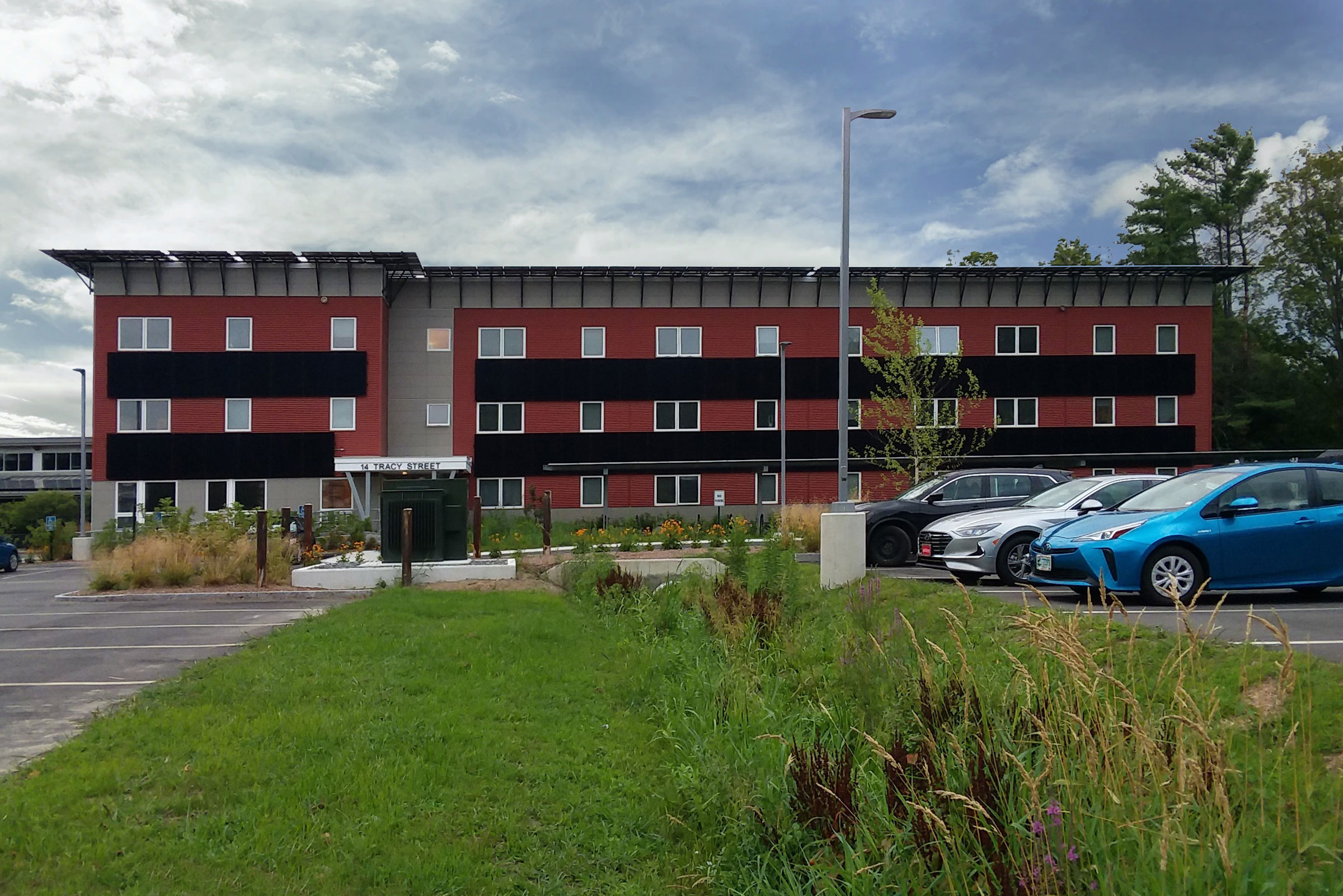
Tracy Community Housing was recognized as the Source Zero Winner in the 2020 Phius Design Competition. Photo courtesy of Maclay Architects
Tracy Community Housing
Source Zero Winner
In an infill lot in West Lebanon, New Hampshire, Maclay Architects built Tracy Community Housing as a durable, healthy, and attractive housing option with minimal energy costs on a limited budget.
The community housing offers 29 units of family housing and is all-electric. With natural, welcoming outdoor spaces and common spaces that have larger windows and tan panel siding to delineate from the red corrugated metal of private areas, the building is built thoughtfully for life.
The building reaches net zero with vertical solar panels on the south elevation, roof, and arbor, and high performance insulation to minimize thermal bridging. The solar power provides 110% of estimated building energy use each year.
- CPHC: EcoHouses of Vermont
- Builder: Estes & Gallup
- Architect: Maclay Architects
- QA/QC Rater: VEIC

Wildwood Passive House received the Source Zero Honorable Mention in the 2020 Phius Design Competition. Photo courtesy of Evolutionary Design Build
Wildwood Passive House
Source Zero Honorable Mention
The first in a new development by Evolutionary Home Builders, Wildwood Passive House will serve as the model home for 27 other lots in the development dedicated to Passive House standards and will create a shared microgrid and virtual power plant.
Offsite prefabricated wall panels and roof trusses came together to build Wildwood passive house with airtight sheathing and insulation. The all-electric home uses heat pump heating and cooling, hot water, and dryer, induction cooking, and electric vehicle charging.
Because the development aims to merge lifestyle, nature, and community on the property, the solar energy is shared with the microgrid infrastructure and battery storage system. Residents will have access to onsite composting, an electric car charging station, and onsite bee hives. The community aims to restore surrounding wildlife and provide a beautiful natural living environment through the services of modern technology.
- CPHC: Lisa White
- Builder: Evolutionary Home Builders
- Architect: Evolutionary Design Build
- QA/QC Rater: Eco Achievers

